It takes two to speak the truth—one to speak and another to hear. Henry David Thoreau
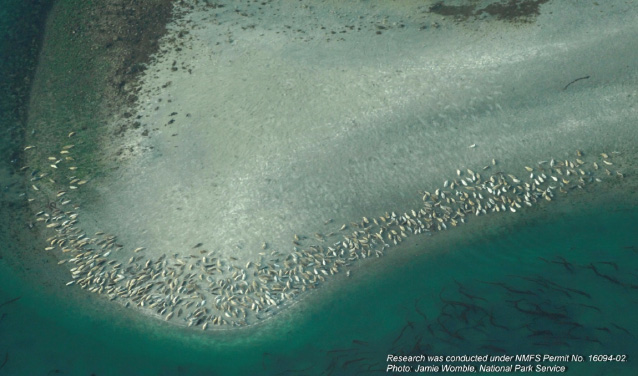
NPS Photo
Scientists in Glacier Bay National Park are studying marine mammals with their eyes closed. In 2015, with funding from a National Park Foundation Coastal Marine Grant, park scientists began an exciting new collaboration with researchers from Oregon State University and Syracuse University to document how harbor seals and humpback whales use sound in daily life, and to evaluate the extent to which man-made noise hinders successful communication (Figure 2). Building on the legacy of long-term studies of whales, seals, and underwater sound in Glacier Bay, this study will help scientists determine whether whales and seals alter their vocal behavior in response to vessel noise.
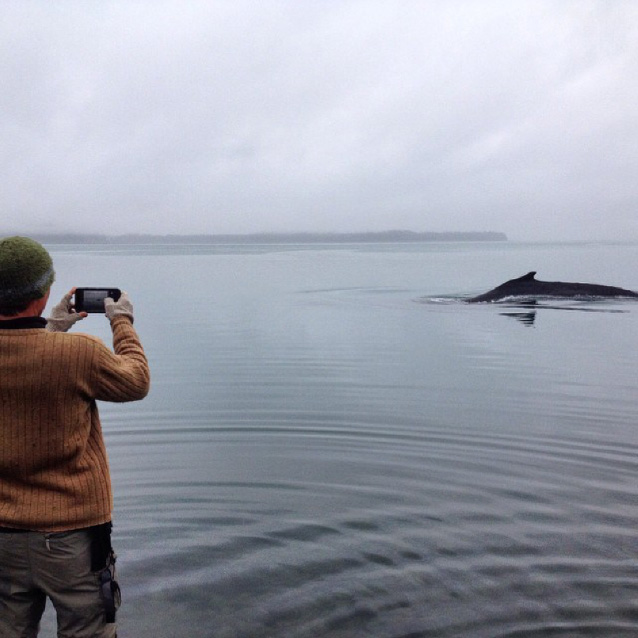
The Glacier Bay/Icy Strait area is the summer feeding range for nearly 250 humpback whales (Megaptera novaeangliae) and home to over 5,000 harbor seals (Phoca vitulina richardsii; Womble et al. 2010, Allen and Angliss 2015, Neilson et al. 2015; Figure 3). Because these acoustically adept mammals share their habitat with other sound sources such as vessels, wind, rain, melting ice, and calving glaciers, it stands to reason that understanding some of the basic truths about how marine mammals use sound requires researchers to listen. Passive listening with automated audio recording devices is a non-invasive way to track vocal animals and better understand their relationships to other sounds in their environment (also known as acoustic ecology).
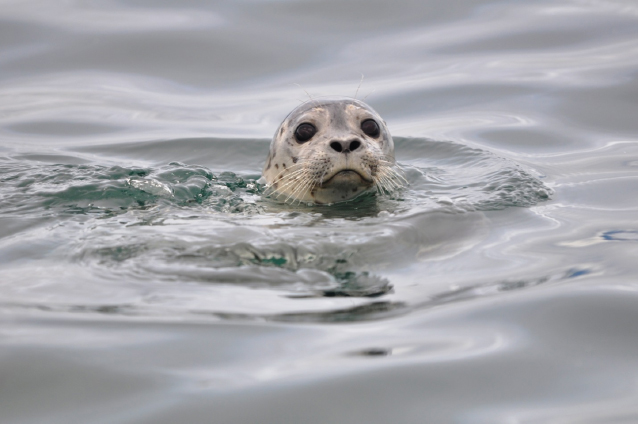
NPS Photo
In a nutshell, this study seeks to clarify the physical description and context of seal and whale vocal behavior. Understanding how marine mammals interact vocally with others of their species brings us closer to assessing the biological implications of human impacts on the underwater sound environment.
Biological Context
Humpback whale and harbor seal vocalizations are well-adapted for the marine environment, but also overlap considerably with man-made sounds, including vessel noise (Richardson et al. 1995; Fournet et al. 2015).
Study Questions
• How loud are harbor seal roars and humpback
whale calls?
• How often do individual animals produce
these calls?
• In what behavioral context are calls produced?
• Do other animals call or otherwise react
to an individual’s calls?
• Does loudness, calling rate, or behavior
change in the presence of vessel noise?
Harbor seals rely heavily on acoustic communication for reproductive success, including passive listening to detect predators (Deecke et al. 2002), as well as vocalizing during the mating season. Harbor seals, like most seal species, mate underwater (Van Parijs et al. 1997). During the breeding season, male seals establish underwater territories and use acoustic signals, known as “roars,” to defend these territories from intruder males and possibly to attract females (Hanggi and Schusterman 1994; Hayes et al. 2004). Harbor seals are found in a variety of habitats, including glacial ice floes, sand bars, and rocky beaches (Bigg 1981). They return to the same breeding grounds every year to mate and give birth to pups (Boness et al. 2006). About 70 percent of the harbor seals in Glacier Bay occur at the primary glacial ice site in Johns Hopkins Inlet. For our study, we selected a site near the Spider Island Reef complex, where pupping occurs in late spring and over 700 seals haul out for molting in late summer (Womble et al. 2015; Allen and Angliss 2015).
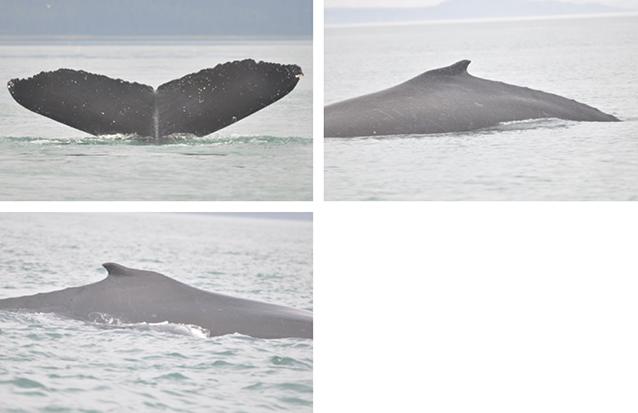
NPS Photos taken under National Marine Fisheries permits.
Humpback whales are probably best known for the males’ long, complex songs produced mainly in sub-tropical breeding grounds (Payne and McVay 1971), but also in Alaska (Gabriele and Frankel 2002). They produce a wide variety of non-song calls in Southeast Alaska (D’Vincent et al. 1985; Wild and Gabriele 2014; Fournet et al. 2015) for which the exact functions are unknown. Humpback whales are long-lived social baleen whales that maintain complex multi-year social bonds (Baker 1985; Ramp et al. 2010; Hanser 2009; Sharpe et al. 2013; Pierszalowski et al., in review), thus in general their calls likely play a critical role in maintaining these bonds over space and time. Some of the calls produced in Glacier Bay, including a commonly heard “whup” call, may act as a contact call (Wild and Gabriele 2014), while others may be linked to foraging behaviors (D’Vincent et al. 1985) or facilitate social interactions (Fournet 2014).
The story of underwater sound monitoring in the park centers on a long-standing concern that the presence of vessel-generated noise has the potential to disturb marine mammals and other wildlife. In Glacier Bay, the study of acoustic ecology dates back to landmark projects in the 1980s that quantified the underwater soundscape and demonstrated that humpback whales in Glacier Bay change their behavior in the presence of vessels (Malme et al. 1982; Baker 1985). Park scientists began regular monitoring of ambient underwater noise in 2000. Vessel noise contributes dramatically to the park’s underwater soundscape (Kipple and Gabriele 2004; McKenna et al. in review; and Gabriele et al. 2015) and reduces the communication space available for whales and seals (Clark et al. 2009; Gabriele et al. 2010, 2015). However, several important questions remain about acoustic behavior in harbor seals and humpback whales. Which brings us back to listening…
Field Season 2015
In late May 2015, we started listening. The research team chartered a vessel to deploy the hydrophone array that lies at the heart of this project. The array consists of four underwater microphones (hydrophones) with electronics to record audio continuously in the waters of Beardslee Entrance in Lower Glacier Bay. This site was chosen because it is near the large harbor seal haul-out at Spider Island Reef and is a place where humpback whales are known to feed in spring through fall. We chose each hydrophone’s location carefully, crossed our fingers for luck, and left them to do their work until October. In mid-June, the visual observers arrived and set up camp overlooking the hydrophone array.
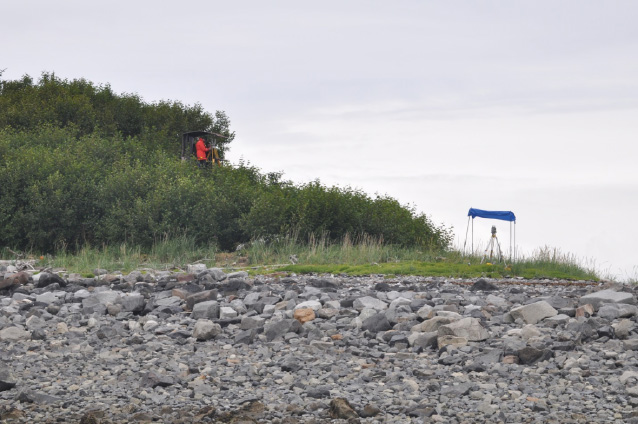
NPS Photo
From their tents on Strawberry Island, the five-person field team could hear the sniffs of harbor seals in the intertidal, and feel the vibrating boom of humpback whale breaches. From mid-June through mid-August, the team lived on the island collecting behavioral data from a peninsula that overlooked a seal haul-out and humpback whale foraging ground (Figure 4). Poised in an elevated hunter’s blind and outfitted with binoculars and a surveyor’s transit (Figure 5), the team conducted focal follows of humpback whales. They selected an individual whale and documented its every action, marking its location as it surfaced, dove, and moved through the survey area. Simultaneously, another pair of researchers on the beach with similar equipment marked the location of every visible whale and vessel, as well as photographing any seal or whale that came close enough to be identified based on individual markings. This combination of methods allowed us to document the fine-scale behavior of individual focal animals in the context of the other animals and vessels in the area, without becoming part of the scene. Identification photographs allow behavior to be interpreted in the context of age, sex, and reproductive status, using life history data from the Glacier Bay humpback whale monitoring program (Neilson et al. 2015).
Field Results 2015
At the time of this writing, the hydrophones are on land, but still wet: the research team successfully (and gratefully) retrieved all four recording units in late October 2015 (Figure 6). The unspoken truth is, when you put equipment in the ocean, there’s always a possibility that you won’t get it back! The electronics worked perfectly, and each of the four recording units has about 3,800 hours of audio data on it. Now the hard work begins. The recordings will be examined over the winter for seal and whale vocalizations as well as vessel noise and environmental noise.
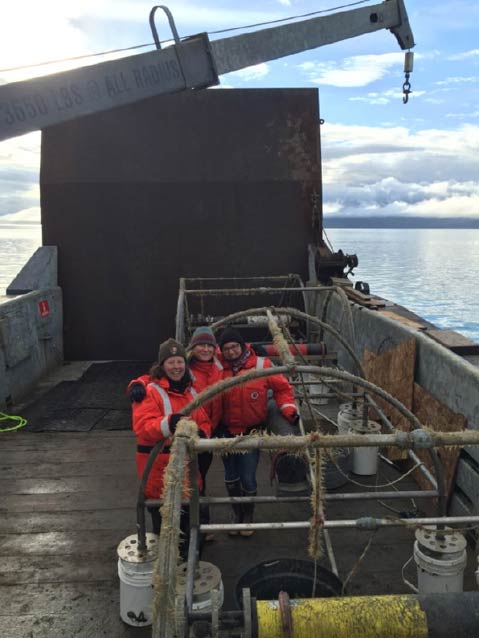
NPS Photo
With audio from the four hydrophones, we can use triangulation to locate the underwater positions of vocalizing whales and seals. By stringing a series of acoustic locations together, calling whales and seals can be “tracked” underwater; their calls can be classified and described, and calling rates can be calculated (Figure 7). Once the location has been determined of the calling animal, we can estimate the loudness of the call based on the known distance from the hydrophone and the physics of how sound travels underwater. Quantifying the variability in how loud the calls are gives an indication of how detectable these calls will be (to other whales or seals) when the underwater sound environment gets noisy. Understanding how often animals are calling provides clues into why the calls are produced and how these animals may adapt to noise from wind, rain, vessels, or any other sounds in their acoustic environment. Vessel noise was audible in air and underwater from the observation site, and will be quantified with audio data from the hydrophone array.
Over the eight-week field season, the Strawberry Island team conducted upward of 400 focal follows and over 500 scan point surveys. On average, there were six humpback whales sighted during each scan point survey, but on some days researchers documented as many as 24 whales spending time in the vicinity of the Beardslee Island complex. Individual whales linger to feed in a given area for days or weeks at a time, so we don’t know exactly how many different individuals were observed. Researchers are currently processing close to a thousand photographs taken of whales and seals in an effort to identify animals that may have known life histories.
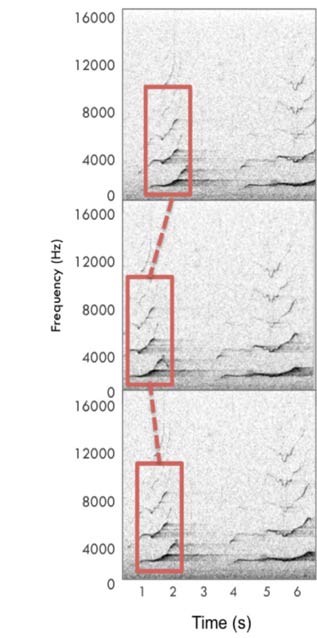
Harbor seals were visually detected on every sampling day, and the observers grew very familiar with one “resident” harbor seal that was seen almost daily near their observation site. A number of seals are found in the water near the Spider Island Reef Complex, the largest terrestrial site for harbor seals in Glacier Bay. Results from the park’s annual aerial survey in 2015 will provide an estimate of the number of harbor seals on shore during pupping (June) and molting (late July and August; Womble et al. 2010, 2015) to give context to our findings.
Insights and Discoveries
The best kind of research generates at least one new question for every answer it provides—such is the nature of human curiosity. A few tantalizing observations have already surfaced in this study. From previous ambient noise studies in Glacier Bay, we expected that we’d hear seals often, so it came as no surprise that harbor seal roars were detected every time the team listened from a kayak with a portable hydrophone. In fact, it was sometimes difficult for the listener to hear anything else with a seal roaring nearby, demonstrating that man-made noise is not the only factor that animals must accommodate in acoustic ecology. It was an unexpected and pleasant surprise to hear harbor seal roars as late as mid-August, since we presumed that seals would cease roaring at the end of the breeding season, presumably in July. This previously undescribed prolonged period of roaring may provide insight into the length of the breeding period of Glacier Bay harbor seals or suggest that roaring serves other purposes along with protecting breeding territories.
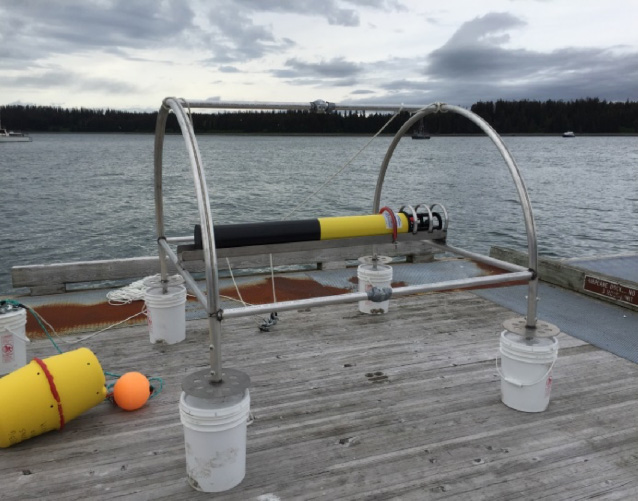
NPS Photo
Research is above all the great admission of not knowing. In Glacier Bay this not knowing is palpable and comfortable. It gives our team the chance not just to seek answers, but to seek questions.
~Michelle Fournet 2015 field notebook
More discoveries will undoubtedly arise from such a rich visual and acoustic dataset. In addition, having a field team living so closely with their study species has already led to novel insights that are beyond the scope of the initial study design. For example, humpback whales in Glacier Bay are known to maximize foraging by taking advantage of tidal current patterns at headlands (Chenoweth et al. 2011). Anecdotally, researchers observed humpback whales in tidal headlands that appeared to be disturbing bottom substrate in shallow water (about 19.6 feet [6 meters]) and lunging toward the surface after small prey. If these disturbances are audible on the hydrophones (the sound of grinding gravel), our research may confirm that humpback whales are actively foraging in the benthos of the high intertidal zone. This hypothesis would not have been formulated if it were not for the ability to observe humpback whales closely and continuously in their environment without disturbing them (Figure 8).
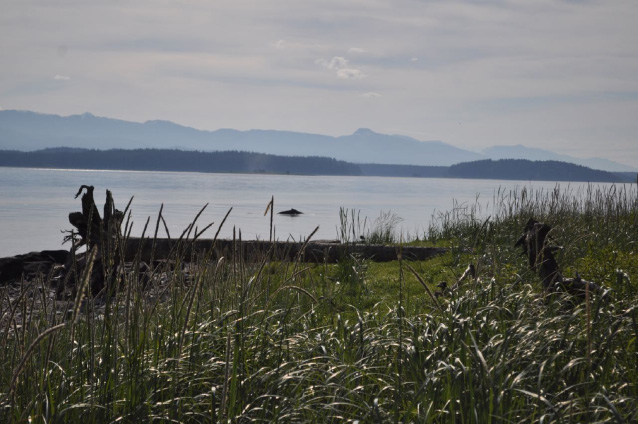
NPS Photo
Planning for 2016 and Beyond
In 2016, the hydrophones have been redeployed for several more months of acoustic data collection. The researchers are taking what they learned from acoustic tracking analysis and fine tuning the behavioral observation protocols. Data from this study will be a major component in the doctoral dissertations of Matthews and Fournet, and aspects of the study will be published in scientific journals and presented at scientific conferences. We’ll be producing a short video to share with students and the general public. We will continue to update our new Currents: Ocean Science Hub blog to share a variety of Glacier Bay ocean research projects with the maritime community. We’ll expand upon these educational efforts in 2016.
In the end, we hope the most important outcomes will extend to the seals and whales themselves. They may not have noticed that we were there and were eavesdropping, but nevertheless, they stand to benefit from an improved understanding of how marine mammals interact with sounds in their underwater world.

NPS Photo
Acknowledgements
Big thanks to the 2015 student field crew from Oregon State University (David Culp, Tom Plank, Lucas Williams, Kate Popisil). Installing and retrieving hydrophones was made easy by the M/V Lite Weight (Paul Weltzin, John Martin, and of course, Betty the dog). Huge thanks to the engineers at the National Oceanic and Atmospheric Administration-Pacific Marine Environmental Lab who built and outfitted the hydrophones, and trained our team, as well as all of the oceanographers and acousticians who we consulted on mooring design and deployment techniques. We also couldn’t have done it without Glacier Bay National Park maintenance staff that specializes in fixing equipment and moving heavy things (Dustin Hazen, Jonathon Bier, Bruce McDonough, and others). Craig Murdoch was our fuel cell guru and Wes Bacon-Schulte helped us troubleshoot our surveyor’s instrument. Todd Bruno of the M/V Capelin transported our team to and from Strawberry Island throughout the summer, and delivered a few much needed icebergs. Kayak training by Corey and Linsey Dusin helped keep us safe on the water and bear safety consultations by Christopher Behnke and Tania Lewis helped us keep a bear-free camp and sleep well at night. Lastly, thank you to Cheryl Cook and Kathy Hocker for the use of their cabin when the team needed a roof to sleep under. Funding for this study was provided by the Coastal Marine Grant administered by the National Park Foundation.
References
Allen, B. and R. Angliss. 2015.
Alaska marine mammal stock assessments, 2014. U.S. Department of Commerce, NOAA Technical Memo, NMFS-AFSC-301: 304p.
Baker, C. 1985.
Population structure and social organization of humpback whales (Megaptera novaeangliae) in the central and eastern North Pacific. Honolulu: University of Hawaii.
Bigg, M. 1981.
Harbour seal, Phoca vitulina and Phoca largha. Handbook of Marine Mammals (Ed. By S. H. Ridgway & R. J. Harrison), pp. 1-28. New York: Academic Press.
Boness, D., W. Bowen, B. Buhleier, and G. Marshall. 2006.
Mating tactics and mating system of an aquatically-mating pinniped: the harbor seal, Phoca vitulina. Behavioral Ecology Sociobiology 61: 119-130.
Chenoweth, E., C. Gabriele, and D. Hill. 2011.
Tidal influences on humpback whale habitat selection near headlands. Marine Ecology Progress Series 423: 279-289.
Clark, C., W. Ellison, B. Southall, L. Hatch, S. Van Parijs, A. Frankel, and D. Ponirakis. 2009.
Acoustic masking in marine ecosystems: intuitions, analysis, and implication. Marine Ecology Progress Series 395: pp. 201-222.
Clark, C., D. Ponirakis, and C. Gabriele. 2013.
Preliminary Analysis of 2011 Underwater Acoustic Environment in Glacier Bay National Park and Preserve. Progress Report to the National Park Service 40 pp.
Deecke, V., P. Slater, and J. Ford. 2002.
Selective habituation shapes acoustic predator recognition in harbour seals. Nature 420 (14 December, 2002): 171-173.
D’Vincent, C., R. Nildon, and R. Hanna. 1985.
Vocalization and Coordinated Feeding Behavior of the Humpback Whale in Southeastern Alaska. Scientific Reports of the Whales Research Institute 36: 41-47.
Fournet, M. 2014.
Vocal Behavior of Southeast Alaskan humpback whales (Megaptera novaeangliae): Classification and context. Master’s Thesis, Marine Resource Management. Oregon State University.
Fournet, M., A. Szabo, and D. Mellinger. 2015.
Repertoire and classification of non-song calls in Southeast Alaskan humpback whale (Megaptera novaeangliae). Journal of Acoustic Society of America 137: 1-10.
Gabriele, C. and A. Frankel. 2002.
Surprising Humpback Whale Songs in Glacier Bay. Alaska Park Science Winter 2002: 16-21.
Gabriele, C., C. Clark, A. Frankel, and B. Kipple. 2010.
Glacier Bay’s underwater sound environment: the effects of cruise ship noise on humpback whale habitat. Alaska Park Science 9(2): 12-17.
Gabriele, C., D. Ponirakis, C. Clark, J. Womble, and P. Vanselow. 2015.
Calculating Acoustic Environment Metrics for Glacier Bay Marine Mammals. Poster presentation at Alaska Marine Science Symposium, Anchorage Alaska,
January 2015.
Hanggi, E. and R. Schusterman. 1994.
Underwater acoustic displays and individual variation in male harbour seals, Phoca vitulina. Animal Behaviour 48: 1275-1283.
Hanser, S. 2009.
Toward the Social and Acoustic Ecology of Social Foraging Humpback Whales (Megaptera novaeangliae) in Southeast Alaska. PhD thesis. Davis: University of California.
Hayes, S., D. Costa, J. Harvey, and B. Boeuf. 2004.
Aquatic mating strategies of the male Pacific harbor seal (Phoca vitulina richardii): Are males defending the hotspot? Marine Mammal Science 20: 639-656.
Hayes, S., A. Kumar, D. Costa, D. Mellinger, J. Harvey, B. Southall, and B. Boeuf. 2004.
Evaluating the function of male vocalizations in the harbor seal (Phoca vitulina) through playback experiments. Animal Behaviour 67: 1133-1139.
Kipple, B. and C. Gabriele. 2004.
Glacier Bay watercraft noise - noise characterization for tour, charter, private and government vessels. Naval Surface Warfare Center. Technical Report. NSWCCD-71-TR-2004/545 47: 45 pp.
McKenna, M., C. Gabriele, and B. Kipple. In Review.
Effects of marine vessel management on the underwater acoustic environment of a protected coastal habitat. Ocean and Coastal Management.
Malme, C., P. Miles, and P. McElroy. 1982.
The acoustic environment of humpback whales in Glacier Bay and Frederick Sound/Stephens Passage, Alaska. Seattle: U.S. National Marine Fisheries Service, National Marine Mammal Laboratory.
Neilson, J., C. Gabriele, and P. Vanselow. 2015.
Humpback whale monitoring in Glacier Bay and adjacent waters 2014: annual progress report. National Park Service. Natural Resource Technical Report NPS/GLBA/NRTR—2015/949. 30 pp.
Payne, R. and S. McVay. 1971.
Songs of humpback whales. Science 173(3997):
585-597.
Pierszalowski, S., C. Gabriele, D. Steel, J. Neilson, P. Vanselow, J. Cedarleaf, J. Straley, and C. Baker. In review.
Local recruitment and maternal fidelity of humpback whales in Glacier Bay and Icy Strait, Alaska confirmed with photo-ID and DNA profiles. Endangered Species Research.
Ramp, C., W. Hagen, P. Palsbøll, M. Bérubé, and R. Sears. 2010.
Age-related multi-year associations in female humpback whales (Megaptera novaeangliae). Behavioral Ecology and Sociobiology 64: 1563-1576.
Richardson, W., C. Greene Jr, C. Malme, and D. Thomson. 1995.
Marine mammals and noise. San Diego:
Academic Press.
Sharpe, F., A. Szabo, A. Pack, J. Nahmens. 2013.
The Social Structure of Bubble Net Feeding Whales in SE Alaska. Dunedin, New Zealand: Abstract to the 20th Biennial Conference on the Biology of Marine Mammals.
Van Parijs, S., P. Thompson, D. Tollit, and A. Mackay. 1997.
Distribution and activity of male harbour seals during the mating season. Animal Behaviour 54: 35-43.
Van Parijs, S., V. Janik, and P. Thompson. 2000.
Display-area size, tenure length, and site fidelity in the aquatically mating male harbour seal, Phoca vitulina. Canadian Journal of Zoology 78: 2209-2217.
Womble, J., G. Pendleton, E. Mathews, G. Blundell, N. Bool, S. Gende. 2010.
Harbor seal decline continues in the rapidly changing landscape of Glacier Bay National Park, Alaska, 1992-2008. Marine Mammal Science 26. 686-697.
Womble, J., G. Pendleton, E. Mathews, S. Gende. 2015.
Status and trend of harbor seals at terrestrial sites in Glacier Bay National Park from 1992-2013. Report to Glacier Bay National Park.
Wild, L. and C. Gabriele. 2014.
Putative contact calls made by humpback whales (Megaptera novaeangliae) in southeastern Alaska. Canadian Journal of Acoustics 42(4).
Part of a series of articles titled Alaska Park Science - Volume 15 Issue 1: Coastal Research Science in Alaska's National Parks.
Last updated: November 21, 2016
